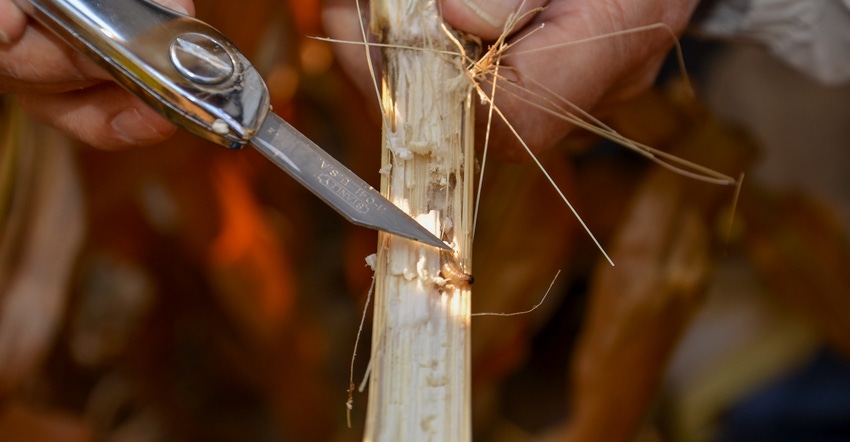
Maybe you remember when there was a real prize inside every box of Cracker Jack. When Dave Nanda sliced into a cornstalk recently, he found one thing he expected and one surprise. If you found the surprise he found inside your box of Cracker Jack, you wouldn’t be impressed!
Nanda, an independent crops consultant based in Indianapolis, expected to find stalk rot because he saw black specks on the outside of the stalk. What he didn’t expect to find a live corn borer larva tucked inside the stalk.
“You need to know what’s happening in your fields all the way to harvest,” Nanda says. “When you’re making decisions about hybrids and management practices for next year, you have more actual information to use.”
Nanda was scouting in the Corn Watch ’17 field before harvest when he made these discoveries. Corn Watch ’17 is sponsored by Seed Genetics-Direct, Washington Court House, Ohio.
Stalk diseases
Nanda was surprised at the minimal number of stalks infected by stalk rot. The real test is at the end of the season. But in some years, when there’s a decent amount of foliar disease pressure, as there was in this field this year, stalks are set up for invasion by stalk rot.
The primary disease affecting foliage was gray leaf spot. As the crop neared maturity, there were also some signs of nitrogen deficiency and even potassium deficiency.
There are various stalk rot diseases. When Nanda sliced open the stalk and saw the dark, black pith developing at each node, he was certain the infection was caused by anthracnose stalk rot.
“Later in the season, any stalks which are infected will have many more black specks on the surface,” he explains. “The surface may even take on a black, slimy appearance.”
Fields where a large number of stalks are infected with stalk rot should be marked for early harvest, Nanda notes. Otherwise, the crop will be more subject to lodging and higher field losses.
Insect enemy
It’s not every day you find a corn borer larva at work inside a stalk near the end of the season these days. That’s because many hybrids include the European corn borer Bt protection trait.
One of the two hybrids in the field had the Roundup Ready trait, but didn’t have protection against corn borer. Some farmers made a conscious decision to leave out corn borer protection this year to save money. In the Corn Watch ’17 field, one of the hybrids the farmer wanted to plant was only available in the non-Bt version by the time he could get seed of that hybrid.
The real tale on corn borer will come at harvest. If borers tunnel into ear shanks, whole ears can fall onto the ground. Tunneling can also open up the plant for stalk rot infection. Fields with stalk borer issues might be marked for early harvest as well, Nanda says.
About the Author(s)
You May Also Like




